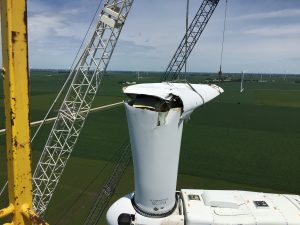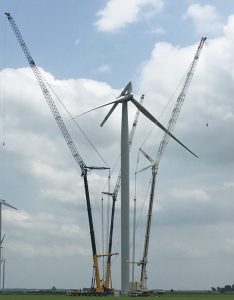Broken Blade Removal A Multi-Branch Effort
When a wind turbine blade breaks, removing it at over 300 feet from the ground can be a challenge.
Barnhart was called to a wind farm in Illinois to remove a broken blade from a wind turbine. The other two good blades had to be removed as well and stored on the ground until a replacement blade could be sourced.
Customarily, blades are removed when the rotor is at a 3 o’clock or 6 o’clock position. In this instance, the rotor was locked out in a 12 o’clock position, with the broken piece of the 145’ blade dangling midway down. This is the most difficult position from which to remove a blade and is rarely completed even in emergency situations. However, turning the rotor to a more favorable position was not possible without risking damage to the other blades, hub and turbine.
It took three rounds of engineering whiteboard design plus numerous consultations with the customer to design a plan of action. Then a storm came through and complicated issues by further damaging the blade, which required a revision to the removal plan.
One consideration was the hub height, which was 265’ to the center of the hub. The eventual removal method utilized three large cranes, two 550-ton and one 600-ton crane, and personnel from several Barnhart branches.
Barnhart performed an initial examination using two of the cranes with man baskets for preliminary rigging and inspection. Photos were then sent to the engineering team in Memphis for review and final design adjustments to the plan.
Due the nature of the work, wind speeds had to be below 15 mph along with a favorable forecast to allow each task to be completed. There were also numerous safety issues to consider, like falling debris and pieces of the broken blade. All non-critical personnel were kept outside the designated perimeter and critical personnel operated under Job Hazard Analysis plans to keep them safe during all segments of the operation.
 Barnhart used two cranes to stabilize the broken blade with multiple slings. The crew was able to sandwich the blade together and contain the pieces in compression to make it rigid enough to cut and lower safely.
Barnhart used two cranes to stabilize the broken blade with multiple slings. The crew was able to sandwich the blade together and contain the pieces in compression to make it rigid enough to cut and lower safely.
The third crane held a man basket with a crew responsible for cutting the broken piece loose around the break. Both pieces were then lowered to the ground for further examination by the customer. The other cranes were used to remove the remaining two good blades.

